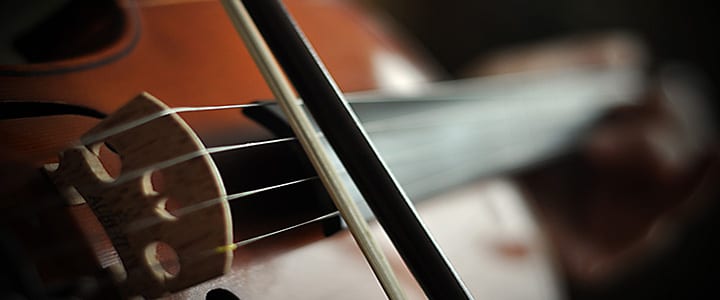Do you want to liven up your practice routine and add new sounds to your existing repertoire? Violin teacher Julie P. shares some new violin techniques that will take your playing to the next level…
As a beginner or intermediate violinist, you’re probably familiar with the basic bowed sound of a violin. However, there are a number of other techniques you may not have heard of yet. Today’s more modern composers are continuing to come up with new bowing techniques to create new and exciting sounds. Below are five violin techniques you should consider trying during your next violin lesson or practice session.
1. Sul ponticello
In normal violin playing, the bow is placed halfway between the bridge and the fingerboard. When a passage is marked sul ponticello, the bow is moved closer to the bridge, or sometimes even right on top of the bridge. This changes the way the bow causes the string to vibrate. So, instead of getting a full tone, the higher harmonics come out. The resulting tone is raspy with an eerie element. Violinists can control which harmonics come to the front of the sound by altering the bow pressure on the string. Listen to a demonstration of sul ponticello in the video below.
2. Sul tasto
In playing sul tasto, the bow is moved in the opposite direction of sul ponticello so that it’s over the end of the fingerboard. This creates a softer, more ethereal sound that can be used for delicate sections of music. This placement of the bow cuts out some of the high harmonics to emphasize the low harmonics. Listen to a demonstration of sul tasto in the video below.
3. Col legno
Col legno – which is translated to “with the wood” – calls for the bow to be turned upside down so that the wood of the bow (not the hair) comes into contact with the strings. If the composer is calling for long bowed notes with the wood of the bow, it’s called tratto. If a more percussive sound is desired, the violinist would strike the string with the bow, also known as battuto. The battuto version can be heard around the 9:16 mark of Hector Berlioz’s Symphonie Fantastique in the video below:
4. Spiccato
In the spiccato stroke, the bow actually comes off the string between bow strokes. This is often referred to as “bouncing the bow,” even though the player’s bow movement is horizontal rather than vertical. Spiccato is usually performed in the middle of the bow where there is even weight on both sides of the contact point, allowing the greatest control over the bow. The tension on the bow hair causes the bounce. Many beginner violinists find that the bow naturally bounces on the strings, until they learn how to control the bow enough to keep it from bouncing. Listen to a demonstration of spiccato in the video below.
5. Ricochet
This technique – which is also referred to as jete – means to bounce the bow rapidly while moving the bow in one direction. Ricochet bowing can be performed at different speeds, determined by the part of the bow that is played. If you “throw” the bow near the middle balance point, it will bounce slower than if you use the upper half of the bow. This technique is used for staccato notes that are all to be played in the same bow direction. Listen to a demonstration of ricochet in the video below.
These five violin techniques are only a few of the unique methods violinists use to make different sounds on their instruments. There are even more ways to play with the bow and make use of the space behind the bridge, the fingerboard, and even the back of the violin. Using the bow in different ways adds a fun element to playing the violin. If you’d like to learn some of these violin techniques, you might want to consider taking violin lessons with an expert teacher.
 Julie P. teaches flute, clarinet, music theory, and saxophone lessons in Brooklyn, NY. She received her Bachelor’s degree in Music Education from Ithaca College and her Masters in Music Performance from New Jersey City University. Learn more about Julie here!
Julie P. teaches flute, clarinet, music theory, and saxophone lessons in Brooklyn, NY. She received her Bachelor’s degree in Music Education from Ithaca College and her Masters in Music Performance from New Jersey City University. Learn more about Julie here!
Photo by Flood G.
Suzy S.


